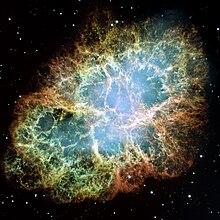Near-Earth supernova

A near-Earth supernova is an explosion resulting from the death of a
.An estimated 20
Effects on Earth
On average, a
Historically, nearby supernovae may have influenced the
Odenwald[8] discusses the possible effects of a Betelgeuse supernova on the Earth and on human space travel, especially the effects of the stream of charged particles that would reach the Earth about 100,000 years later than the initial light and other electromagnetic radiation produced by the explosion.
Risk by supernova type
Candidates within 300 pc[3] Star designation Distance
(pc)Mass
(M☉)IK Pegasi 46 1.65/1.15 Spica 80 10.25/7.0 Alpha Lupi 141 10.1 Antares 169 12.4/10 Betelgeuse 197 7.7–20 Rigel 264 18
Speculation as to the effects of a nearby supernova on Earth often focuses on large stars as Type II supernova candidates. Several prominent stars within a few hundred light years of the Sun are candidates for becoming supernovae in as little as 1,000 years. Although they would be extremely visible, if these "predictable" supernovae were to occur, they are thought to pose little threat to Earth.
It is estimated that a Type II supernova closer than eight
Type Ia supernovae are thought to be potentially the most dangerous if they occur close enough to the Earth. Because Type Ia supernovae arise from dim, common white dwarf stars, it is likely that a supernova that could affect the Earth will occur unpredictably and take place in a star system that is not well studied. The closest known candidate is IK Pegasi.[11] It is currently estimated, however, that by the time it could become a threat, its velocity in relation to the Solar System would have carried IK Pegasi to a safe distance.[9]
Past events
Evidence from daughter products of short-lived
Past supernovae might be detectable on Earth in the form of metal isotope signatures in
In 1998 a
See also
References
- ^
Kaplan, D. L.; Chatterjee, S.; Gaensler, B. M.; Anderson, J. (2008). "A Precise Proper Motion for the Crab Pulsar, and the Difficulty of Testing Spin-Kick Alignment for Young Neutron Stars". S2CID 17840947.
- ^ Joshua Sokol (Jan 14, 2016). "What If History's Brightest Supernova Exploded In Earth's Backyard?". The Atlantic.
- ^ . 29.
- ^
Ellis, J.; Schramm, D. N. (1993). "Could a nearby supernova explosion have caused a mass extinction?". Proceedings of the National Academy of Sciences of the United States of America. 92 (1): 235–8. PMID 11607506.
- ^ a b
Whitten, R. C.; Borucki, W. J.; Wolfe, J. H.; Cuzzi, J. (1976). "Effect of nearby supernova explosions on atmospheric ozone". Nature. 263 (5576): 398–400. S2CID 4154916.
- ^ Petersen, Carolyn Collins (March 22, 2023). "Did Supernovae Help Push Life to Become More Diverse?". Universe Today. Retrieved 2023-03-23.
- PMID 36937070. e9898.
- ^ Odenwald, Sten (2017-12-06). "The Betelgeuse Supernova". Huffington Post. Retrieved 21 April 2020.
- ^ a b c
Gehrels, N.; et al. (2003). "Ozone Depletion from Nearby Supernovae". S2CID 15078077.
- ^
Clark, D. H.; McCrea, W. H.; Stephenson, F. R. (1977). "Frequency of nearby supernovae and climatic and biological catastrophes". S2CID 4147869.
- Bibcode:2007S&T...113c..26G.
- ^ Taylor, G. J. (2003-05-21). "Triggering the Formation of the Solar System". Planetary Science Research. Retrieved 2006-10-20.
- ^
Staff (Fall 2005). "Researchers Detect 'Near Miss' Supernova Explosion". University of Illinois College of Liberal Arts and Sciences. p. 17. Archived from the originalon 2006-09-01. Retrieved 2007-02-01.
- ^
Knie, K.; et al. (2004). "60Fe Anomaly in a Deep-Sea Manganese Crust and Implications for a Nearby Supernova Source". PMID 15525065.
- ^ a b c
Fields, B. D.; Ellis, J. (1999). "On Deep-Ocean 60Fe as a Fossil of a Near-Earth Supernova". S2CID 2786806.
- ^ Fields & Ellis, p. 10
- S2CID 201868513.
- ^
Melott, A.; et al. (2004). "Did a gamma-ray burst initiate the late Ordovician mass extinction?". S2CID 13124815.
- PMID 32817482.
- ^
Aschenbach, B. (1998). "Discovery of a young nearby supernova remnant". S2CID 4426317.
- ^
Iyudin, A. F.; et al. (1998). "Emission from 44Ti associated with a previously unknown Galactic supernova". Nature. 396 (6707): 142–144. S2CID 4430526.
- S2CID 4426317.


